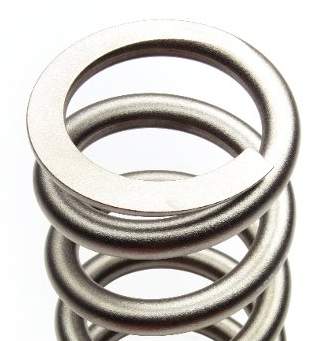BARE BONES: TITANIUM SHOCK SPRINGS VS. STEEL BY BONES BACON
 Bones analyzing Ryan Villopoto’s project KX250 two-stroke suspension earlier this year.
Bones analyzing Ryan Villopoto’s project KX250 two-stroke suspension earlier this year.
Titanium shock springs and fork springs have been around for a while. In the past, titanium shock springs were typically only found on works bikes. What is the allure of having such a costly shock spring? Weight. Titanium shock springs are much lighter than the production steel springs that came on bikes in years past. Factory bikes have always been fitted with exotic lightweight components, CNÇ-machined parts, titanium bolts and carbon fiber mufflers, as well as titanium shock springs. In the never-ending effort to make race bikes as light as possible, a titanium shock spring is a big step in that direction. All the titanium nuts and bolts and other lightweight parts may add up to grams or ounces saved on a bike, but a titanium shock spring can save a pound or two.
Manufacturers have also struggled with trying to get the best performance out of their bikes without raising the cost. Yamaha put titanium shock springs on its production bikes for several years to save a big chunk of weight.
Our Pro Circuit race bikes have run titanium shock springs since back in the two-stroke days. We, like most other factory teams, reaped the benefits of saving weight. But, for us, there was an even greater reason to have those springs on our race bikes—performance. They outperformed the steel springs by so much that if our riders didn’t know we were installing a titanium shock spring, they would think we had changed the linkage or a shock setting. When Grant Langston first raced for our team, he disliked titanium shock springs because of a previous bad experience. So, while he thought we were changing the damping settings when we had the shock off his bike, we were actually putting a Ti spring on. When he took the bike out again, he thought the rear of the bike was calmer and had more traction and that it took less effort to jump obstacles. We had also gone to a lighter rate in the titanium spring, which is standard procedure when going from steel to titanium. Typically, once the correct spring rate was found for each rider, they all shared the same opinion on performance improvements with the titanium spring.
We later told Grant what we had done, and after a brief period of disbelief, he decided he indeed liked titanium springs.
The reason titanium shock springs can outperform steel is something that engineers disagree on, but it is related to the mass of the spring. In non-engineering terms, there is basically less weight (mass) to move and change directions as the spring is compressing and then returning. As the shaft speed of the shock gets higher, and the shaft as well as the spring have to change directions more quickly, having less mass can be a distinct performance advantage.
It may sound like a titanium shock spring is a must-have. Not so fast. A new crop of steel shock springs has made its way on to production bikes, as well as factory race bikes. High-strength-steel (HSS) shock springs are now lighter thanks to a thinner coil diameter and a shorter overall length. HSS material has proven to be durable enough to put onto production bikes. It costs less than titanium, and the performance seems to be just as good, if not better. Titanium springs still have a slight weight advantage, but the cost difference makes up for that.
In the old days, some factory teams used steel shock springs with fewer coils. This made them lighter, but durability was horrible, and they would sack out after a couple of races. Technology has now introduced lightweight, affordable, durable, steel shock springs that are quickly becoming the go-to choice for both factory bikes and production models.
Jim “Bones” Bacon has tuned the suspension of the biggest names in motocross, including Jeremy McGrath, Ricky Carmichael, Ryan Villopoto and Adam Cianciarulo. If you have a suspension question, send it to [email protected].






Comments are closed.